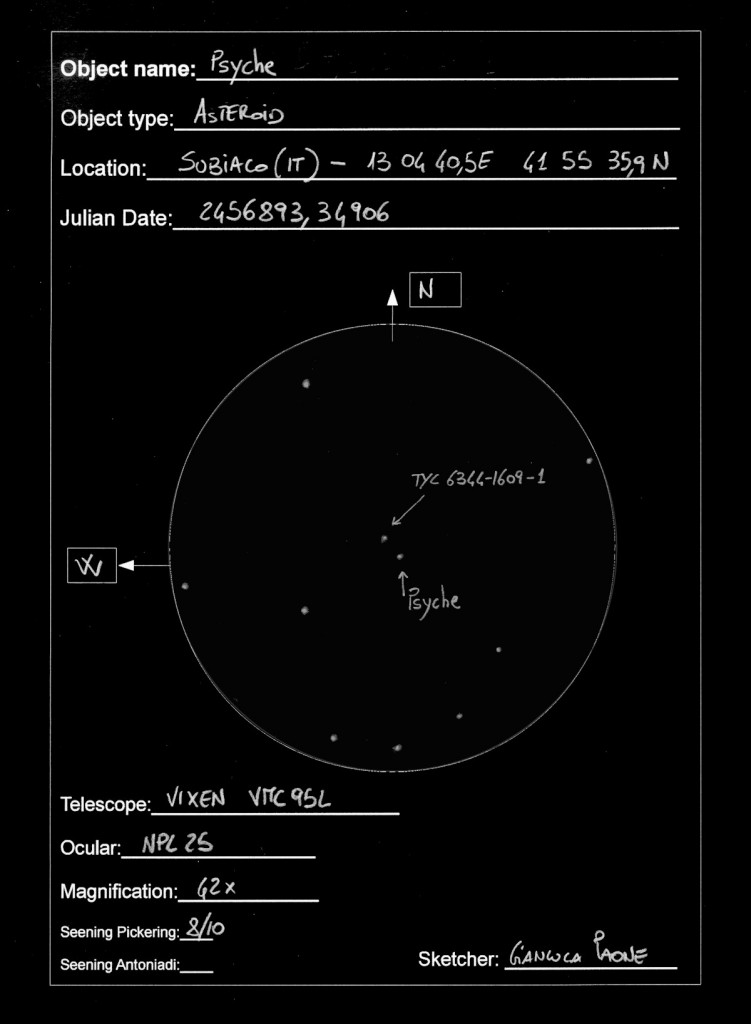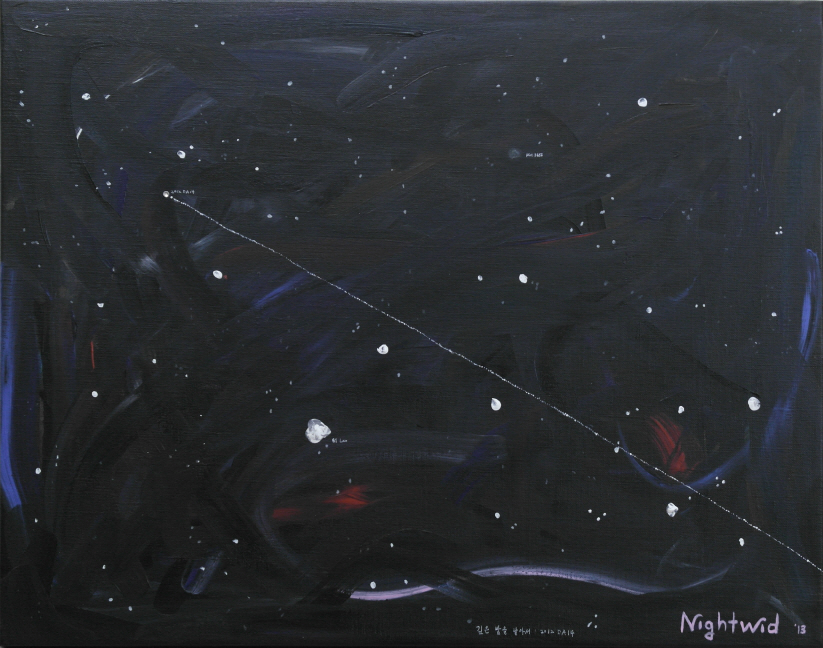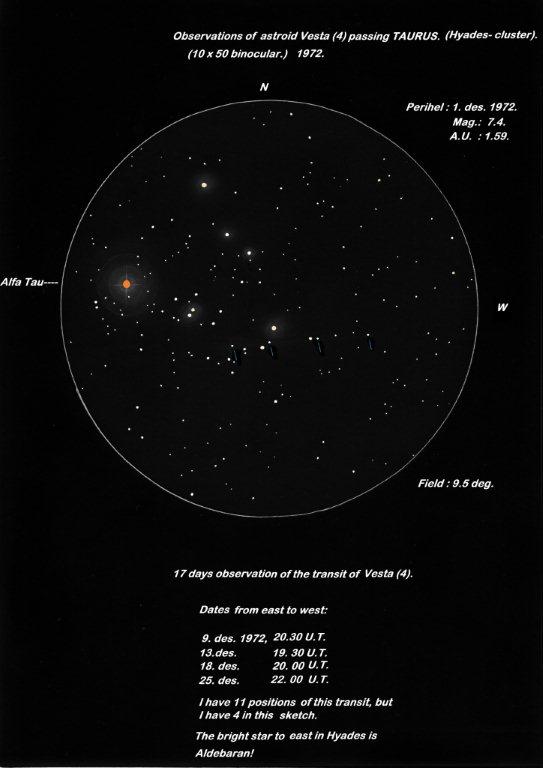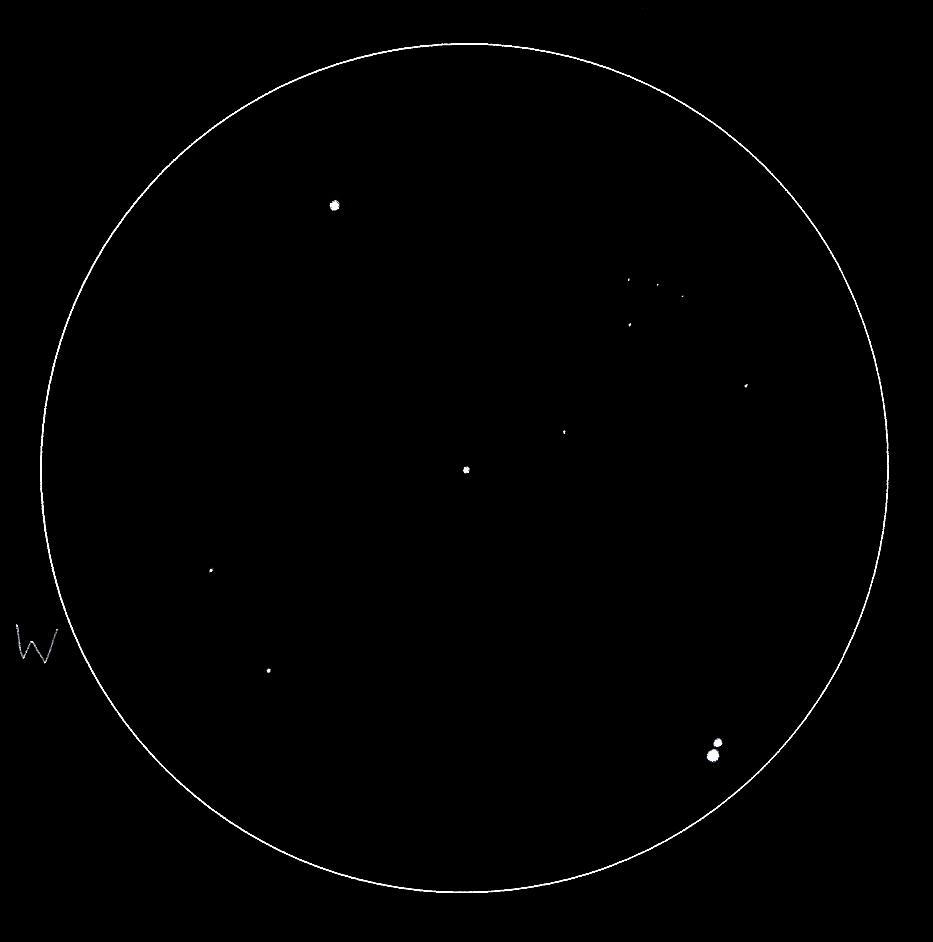
Object name: 16 Psyche
Object type: Asteroid
Location: Subiaco (IT) – 13 04 40.5E 41 55 35.9N
Date: 2014-08-23
Media: graphite pencil
Equipment: 95mm VMC
—
Gianluca Paone
Astronomia Sotto il Lampione – Forum

Object name: 16 Psyche
Object type: Asteroid
Location: Subiaco (IT) – 13 04 40.5E 41 55 35.9N
Date: 2014-08-23
Media: graphite pencil
Equipment: 95mm VMC
—
Gianluca Paone
Astronomia Sotto il Lampione – Forum

It is my first time observation of asteroid.
The tiny stone go by the universe slowly..
It is so cute!!!
Object Name : 2014DA14
Object Type : Asteroid
Location : S. Korea
Date : Feb. 16, 2013
Equipment : Discovery 15″ Dob
Media : White canvas, Acrylic color, crystal beads
Object name: Ceres & Vesta
Object type: asteroids
Location: Subiaco (IT) – 13 04 40.5E, 41 55 35.9N
Date: 2014-07-05
Media: graphite pencil & pastel
Equipment: 95mm VMC
—
Gianluca Paone
Astronomia Sotto il Lampione – Forum

Hey Artists!
Yes, this is a real old, restaurated sketch from the good old days, but it shows asteroid Vestas
movement across the beautiful Hyade star cluster over a observation time of 17 days.
I have org. 11 observations of Vestas positions, but 4 on this sketch. Info on the sketch.
I used pen and pencil on white paper (inverted).
Location: Trondheim, Norway.
I hope you like it!
Best wishes from : Per-Jonny Bremseth.

Object Name: Vesta
Object Type: Asteroid
Location: Itajobi, SP, Brazil
21°19’W
41°03’S
+453m
Date: 21-30/07/2011 (all sketches around 02h00 U.T.)
Media: 2B 0.5mm graphite pencil on white paper, scanned so inverted
Instrument: Binoculars Celestron 10×50 (7°)
Observer: Rodrigo Pasiani Costa
From July 21st to 30th I could observe the brighest asteroid, Vesta, crossing the night sky. Night after night it appeared higher in the sky, always as bright as the surrounding brighest stars, showing its path among them. It was the first time I observed an asteroid, and I didn’t know they move so quickly.
This is an animation with all the sketches, one after another, showing Vesta’s trip:
http://www.youtube.com/watch?v=Up29hcX2z3Y
I hope you enjoy the sketch, and the animation. Thanks you all, and dark skies!
Rodrigo Pasiani Costa

Vesta and Algieba
Sketch and Details by Jef De Wit
Asteroid 4 Vesta reaches opposition on 20 February when it will be opposite the Sun in the sky, making it well placed for observation. At mag. +6.1, this 530 km-diameter space rock is right on the threshold of naked eye visibility from a site with very dark and clear skies (not the case for my backyard L).
Vesta looks just like a star when seen through a telescope and is easily confused with other stars in the area. But on 16 February the asteroid was very easy to spot. It passed almost exactly between Algieba (gamma Leonis) and the fainter 40 Leonis (mag. +4.8) that lies just to the south.
Algieba is nice double star (mag. +2.2 and +3.5, separated by 4.4”) that was easily split. I had trouble seeing colour in the double star. Although both stars are reported as yellow, only the western part looked a little bit yellow to me. The eastern star looked rather bluish.
Source: Sky at Night, February 2010
Clear skies
Jef De Wit
Object Name: Vesta
Object Type: asteroid
Location: Hove, Belgium (51°09’ north lat. 4°28’ east long.)
Date and time: 16 February 2010 around 22.30 UT
Equipment: Orion Optics UK 12” Dobson
Eyepiece: 13mm Nagler T6 (magnification 92x)
FOV sketch: approx 25’
NELM: 4,5 mag
Medium: graphite pencil HB/n°2, printing paper, scanned and inverted, some cleaning up was made with Paint
Asteroid 7 Iris and the Sombrero Galaxy, M104
Sketch and Details by Eric Graff
After taking a look at Boattini’s Comet, I decided to chase down another bit of solar system debris, Asteroid 7 Iris, bearing down on the Sombrero Galaxy (M104) in Virgo; the asteroid was half a degree away from the galaxy and two days from closest approach on May 6, 2008. I had hoped to make additional observations on subsequent nights, but the weather has not been cooperative, so here is my lone observation of this event.
NELM ~6.4; Pickering ~5-6.